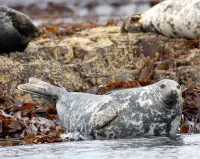Grey seal (Halichoerus grypus) belongs to the family of true seals. This large seal is native to the North Atlantic. It is the only member from its genus. The scientific Greek name of this seal means ‘hooked-nose sea-pig’.
Its coat is greyish-brown to silver in color. Bulls (males) have darker color of their fur. The color of coat on juvenile seals is creamy-white. It has a large snout with no ear flaps. Unlike cow greys, the nose of bulls is larger in size.
Males (bulls) of the eastern Atlantic have a size range of 8.2 to 10.8 feet in length and a weight range of 370 to 680 pounds. However, females (cows) are 5.2 to 6.6 feet long and weigh around 220 to 420 pounds. The seals of the West Atlantic are larger in size.
The weigh t of a newborn pup is 30 pounds.
t of a newborn pup is 30 pounds.
They are found in colonies off Ireland and United Kingdom. Grey seals are present in huge numbers off Northumberland coast, off Lincolnshire, Scottish island Rona, Orkney Islands, coasts of Dublin and Pembrokeshire. The large colonies of such seals are also present off coasts of New Jersey (U.S.) and Canada.
There are a variety of fish on the menu of grey seals like wrasses, sand eels, cod, flatfishes, skates and true cods. They also eat crustaceans like shrimps, crabs as well as cephalopods including octopuses, squids. Occasionally, they are also found to prey on large aquatic mammals like harbour porpoises and common seals. Normally, they have to eat 11 pounds per day and usually goes down to a depth of up to 230 feet during eating.
Other Names: Atlantic seal, Horsehead seal





